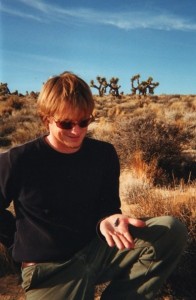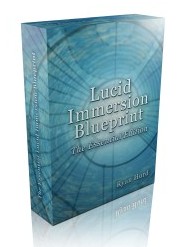
Success in lucid dreaming requires the ability to navigate a realm where gravity is not guaranteed. And where comfortable chats in a café can be interrupted by sudden feelings of spinning, drifting, or falling down an infinite chasm. During the REM dreaming state, as well as during hypnagogia, these sensations ebb and flow thanks to activation in the inner ear as well as the supercharged visual processing of REM.
That’s why working out the inner ear is the key to mastering the weirder aspects of lucid dreaming.
Phasic REM and Vestibular Land Mines
 Lucid dreaming tends to occur during the active form of REM sleep known as phasic REM, which includes greater brain activity as well as more eye movements than tonic REM.
Lucid dreaming tends to occur during the active form of REM sleep known as phasic REM, which includes greater brain activity as well as more eye movements than tonic REM.
Lucid dreams remembered from phasic REM often include awareness of vestibular (inner ear) hallucinations and intense bodily sensations as well.
It’s a trip.
How do you develop confidence during these weird experiences? I have already discussed how playing video games influence lucid dreaming, which combines saturation of an activity with often confusing visual stimuli: perhaps the perfect workshop for developing proprioception.
But we can also take a hint by looking at professional athletes, who reportedly have spontaneous lucid dreams that can improve motor skills and focus.
Furthermore, Hindu yogis and Sufi mystics develop lucid dreaming as a side effect of their bodily training.
These bodily practices all have this in common: the development of balance.
Pick up a Balancing Act
Incorporating a body practice that develops balance and focus is key. If you have lucid roadblocks involving confusion or getting overwhelmed by dizzying sensations, bodywork can help with developing proprioception and field independence.
[pullquote]Success requires the ability to navigate a realm where gravity is not guaranteed.[/pullquote]
You don’t have to become a master yogi though. Just find some activity that is attractive to you and in line with your interests. Some enjoy martial arts, especially the energetic art of Tai Chi.
There’s also rock climbing, bouldering and sailing. Fly-fishing is another example—this is lucid dreaming expert Scott Sparrow’s preferred body meditation.
And don’t forget the Wii.
Inexpensive habits include walking the rail of abandoned train tracks at your lunch hour or following along with a yoga video online.
Even a daily walking meditation develops bodily awareness. Simply take a walk and attend only to your breath and your body as you navigate the landscape. When thoughts come up, acknowledge them, and let them go.
Immerse yourself in the lucid landscape

Personally, I am an avid hiker, stream-walker, and rock scrambler.
Recently, I took a hike in which I walked a fallen tree over a rushing stream. That night, I had a challenging dream that took place on a steel girder high above the ground. I found myself balancing just as I had on the tree trunk in waking life. As I slipped and almost fell, I noticed I could die and that thought led to lucidity.
Rather than escaping the scene or trying to fly, I stuck with the situational physics of the dream and found a solution that led me to safety.
I also enjoy walking terrain to find historic and prehistoric archaeological sites. The practice is intuitive, leading me to prehistoric hunter’s camps, mound sites, and rock clusters where women once pounded acorns and cornmeal while telling stories.
The practice is mirrored in my dreams, where I often discover beautiful ruins, golden treasures, and flint knives glowing in streambeds. The discoveries in the dreams inevitably lead to lucidity.
The beauty of developing a body practice for your lucid life is that you can simply redirect new energy to the things you already love to do. The practice also keeps you grounded and prevents the flighty spinning out that can sometimes accompany an intense new focus on dreaming.
So what’s your balancing act?
—————————————
 This article is adapted from my new digital kit the Lucid Immersion Blueprint, a how-to-guide for really encouraging lucid dreaming.
This article is adapted from my new digital kit the Lucid Immersion Blueprint, a how-to-guide for really encouraging lucid dreaming.
This is not the same old tired stuff about WILDS and DILDS you’ve heard before.
Rather, it’s the latest research in lucid dreaming combined with the ancient wisdom of lucid dreaming lore: the best of the old and the new.
Find out more about the Lucid Immersion Blueprint here.
Great post – among many activites I enjoy is biking and mountain biking. The act of pedaling, finding the best track and enjoying the flow and speed will appear in dreams as ice skating or skiing and normally without skates or skis. Its a lovely feeling of freedom in both worlds
My big one is martial arts. In addition to getting back into my practice of MMA type training I’ve been learning some Tai Chi and Qigong on my own for a little while. The awareness of energy moving through my body has definitely contributed to a couple of out of body experiences/lucid dreams I’ve had recently. It really helps me to feel my dream body and move through the dreamscape. I like that you emphasize body practice for lucid dreaming because it’s a great motivation to remember to be more physically active and holistic. Thanks for the reminder, you nailed it again!
thanks Ryan!
Hi Ryan,
I have read some books on lucid dreaming and even had a few in my life but never at will.
The fun part of the lucid dream was that it was so more expansive then physical reality.
It felt free like swimming in the Ocean.
that expansive feel is really where it’s at! such a breath of fresh air.
Hey would skateboarding work for a balance activity? I could do rock climbing, but I only know of one place with a rock climbing wall, the ymca near my house, and it’s only there for monthly parties, it’s locked up for the rest of the time. I also LOVE climbing trees, but it usually doesn’t require much balance for me, because I always use arm strength and just pull myself up instead of trying to be more strategic, so I guess I’ll give that a shot too… I’d just like to know what would work best, because now that you made this article, a repeating dream from when I was about 8 comes to mind… It doesn’t make much sense, never felt like it had any meaning, but my mind has replayed it several times in my life, always much clearer and more vivid than most dreams are, and I had the same dream about a month or two ago. I just appear on a playground from the daycare I used to go to (14 years old now) and I always just spin crazily, fall off, get up and repeat. This dream always occurs about an hour or so before I get up, and I always try to push myself back to sleep. I always have it in my last rem period (usually sleeping in on the weekends). I wake up, making a spastic movement, not realizing it was a dream, trying to catch myself, and then I go back to sleep.
Just discovered this website by the way, I love the way you write, and I’m definitely going to follow regularly, Thanks for the great article and have a nice day!
thanks Nikos for the kind words. If you’re a skateboarder, by all means — incorporate it into some lucid meditations!
when I have sleep paraylisis and have people walking thru my walls and flashing lights. why do my neighbors report seeing strange lights around my house? I almost got a ticket from fish and game for shinning deer. why do i read in the paper the next day things that have happened in my dreams? my dreams are in color and include smell touch and hearing. i once had a woman say she woke up to see me in her room but when she talked to me i disapeared.